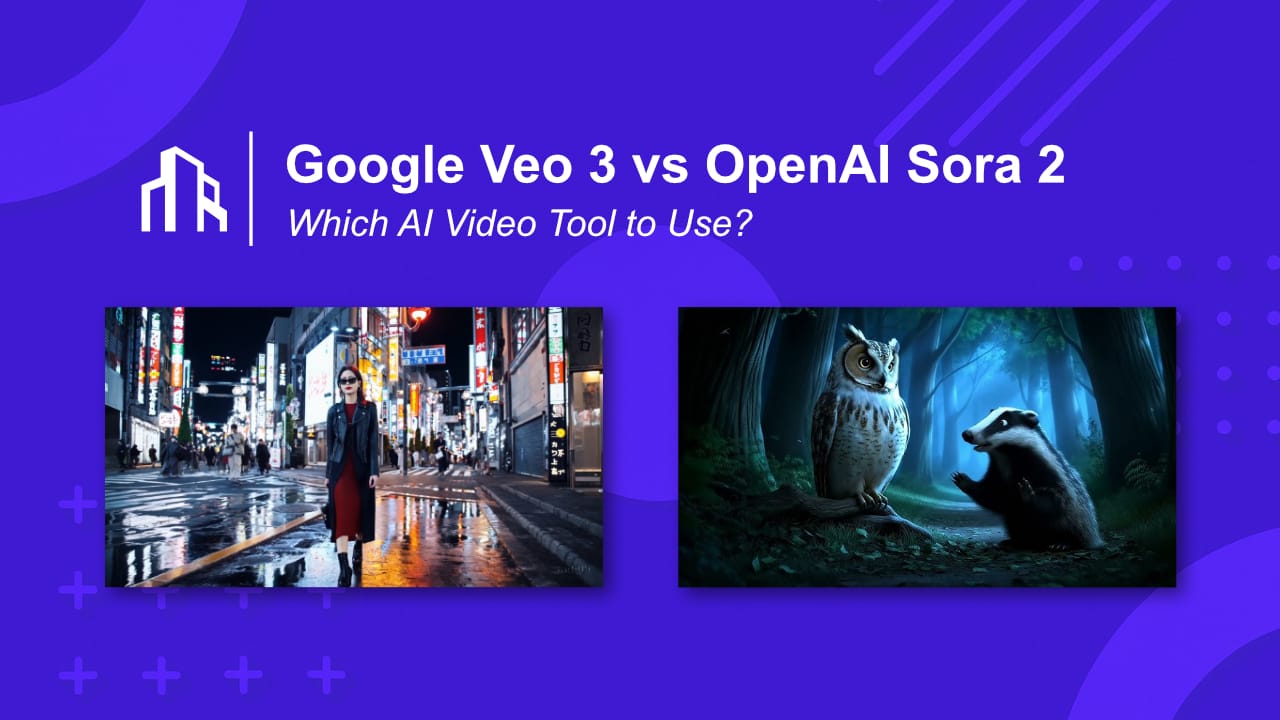Google Veo 3 vs OpenAI Sora 2: Text-to-Video Compared

The generative AI race has shifted from images to video. Two names dominate the conversation today: Google Veo 3 and OpenAI Sora 2. Both represent state-of-the-art text-to-video models, but they are designed with different priorities in mind.
This article provides a clear comparison of Veo 3 and Sora 2: how they work, what makes them unique, and what developers and businesses should know before choosing one. If you are exploring AI video for your workflows, Scalevise can help you implement these tools into scalable systems.
What Is Google Veo 3?
Google announced Veo 3 in 2025 as the latest version of its DeepMind-developed video generation model. Unlike earlier iterations, Veo 3 doesn’t just generate visuals it also integrates native audio, making it one of the first major models to combine sound and video in a single output.
Key highlights of Veo 3:
- Generates videos over one minute long with cinematic motion
- Produces HD and potentially 4K resolution outputs
- Includes dialogue, ambient sound, and effects directly in the generation
- Introduces Flow, a companion system for scene continuity and smoother transitions
- Early reviews note improvements in realism but also limitations in audio syncing and prompt accuracy
Reference: Tom’s Guide on Veo 3.
Google’s long-term edge lies in its ecosystem: integration with YouTube, Google Cloud, and potentially Gemini.
What Is OpenAI Sora 2?
OpenAI Sora 2 is the successor to the first Sora model, released in early 2025. It focuses on short-form, high-fidelity video generation, with better consistency and realism than version 1.
Key highlights of Sora 2:
- Generates 30–60 second clips with sharper details than Sora 1
- Improves temporal consistency, reducing flickering
- More physics-aware motion, better gravity and object interaction
- Built into ChatGPT Pro tiers with wider accessibility than Veo 3
- Includes watermarking and provenance metadata for safety and governance
Reference: OpenAI Sora overview.
OpenAI’s strength is accessibility. By embedding Sora 2 directly into ChatGPT, it allows developers and businesses to experiment immediately.
Head-to-Head: Veo 3 vs Sora 2
1. Length and Resolution
- Veo 3: Capable of longer videos (over one minute) with cinematic fidelity.
- Sora 2: Shorter clips (30–60 seconds) but highly polished.
Winner: Veo 3 for long-form, Sora 2 for polished short-form.
2. Audio Integration
- Veo 3: Generates synchronized audio (dialogue, effects, ambient).
- Sora 2: Video only, no sound generation.
Winner: Veo 3, with audio as a game-changer.
3. Ecosystem Integration
- Veo 3: Limited access, but strong potential via YouTube and Google Cloud.
- Sora 2: Widely available in ChatGPT; easy for businesses to test.
Winner: Sora 2 today, Veo 3 tomorrow.
4. Realism and Physics
- Veo 3: Physics-aware training improves motion realism, but early reviews note issues with complex scenes.
- Sora 2: Physics has improved since version 1 but still struggles in edge cases.
Winner: Tie, both need refinement.
5. Governance and Safety
- Veo 3: Google emphasizes watermarking and deepfake prevention.
- Sora 2: OpenAI enforces watermarking, metadata, and safety filters.
Winner: Both each takes governance seriously.
Also See: Deepfake Protection in Sora 2
Use Cases for Businesses
Marketing and Advertising
- Veo 3: Best for long-form storytelling with integrated sound.
- Sora 2: Ideal for social media ads and campaign variations.
Education and Training
- Veo 3: Extended clips for lectures or immersive lessons.
- Sora 2: Quick, focused explainers for onboarding or training.
Entertainment and Media
- Veo 3: Potential to create cinematic scenes with audio.
- Sora 2: Fast prototyping of animation or concept visuals.
Product Demonstrations
- Veo 3: Longer walkthroughs and feature showcases.
- Sora 2: Short demos for features or product launches.
At Scalevise, we explore how these use cases can be automated with platforms like Make or n8n, so AI video becomes repeatable and scalable.
Risks and Limitations
Both Veo 3 and Sora 2 face challenges:
- Artifacts and glitches: motion errors, continuity breaks
- Bias in outputs: Wired reported stereotyping in Sora 1/2
- Legal uncertainty: copyright, likeness rights, and compliance gaps
- Misuse risk: deepfakes and disinformation across both platforms
Competitive Landscape
The video AI race doesn’t stop with Veo 3 and Sora 2. Other players include:
- Runway Gen-3 — a favorite among indie creators
- Meta’s Make-A-Video — experimental but less visible
- Open-Sora — open-source attempt to rival Sora
Still, Veo 3 and Sora 2 are currently the most influential names in text-to-video AI.
Conclusion
The choice between Google Veo 3 vs OpenAI Sora 2 comes down to scope and availability.
- Veo 3 pushes boundaries with audio + video integration, longer clips, and cinematic fidelity. But it remains limited in access and still early in adoption.
- Sora 2 is available today, polished for short-form outputs, and already embedded into ChatGPT making it far more practical for businesses right now.
For most teams, the pragmatic move is to start with Sora 2 and prepare for Veo 3 once access broadens. The future likely lies in hybrid pipelines that use both tools depending on context.
If you want to explore how text-to-video AI can fit into your workflows, visit Scalevise to see how we help businesses turn cutting-edge tools into scalable solutions.
